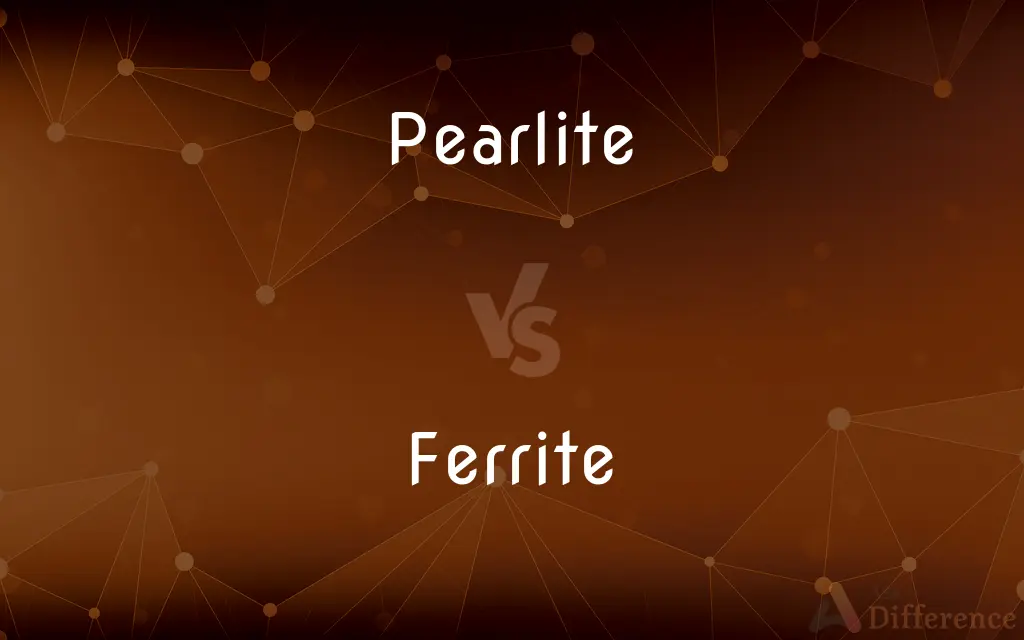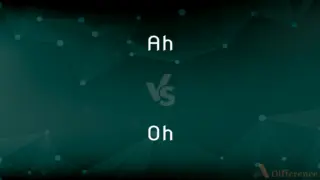Pearlite vs. Ferrite — What's the Difference?
By Tayyaba Rehman & Urooj Arif — Updated on May 8, 2024
Pearlite is a mixture of ferrite and cementite in steel, featuring alternating layers for strength and toughness, while ferrite is a pure iron phase in steel with a body-centered cubic structure, offering good ductility but lower strength.

Difference Between Pearlite and Ferrite
Table of Contents
ADVERTISEMENT
Key Differences
Pearlite and ferrite are both microstructures that occur in steel, impacting its mechanical properties significantly. Pearlite forms when steel cools slowly and consists of alternating layers of ferrite and cementite, giving it a unique balance of strength and ductility. On the other hand, ferrite is a softer, more ductile phase with a lower carbon content, making it less strong but more formable.
Pearlite's structure is designed to withstand both wear and deformation, making it ideal for high-strength applications such as railway tracks and blades. Whereas, ferrite is often found in softer, low-carbon steels used in applications where formability and weldability are more important than high strength, such as in automotive body panels.
The formation of pearlite occurs during the cooling process of steel where the right temperature and cooling rates cause the ferrite to transform and layer with cementite. Conversely, ferrite can form at higher temperatures and persists down to room temperature, generally not undergoing further transformations in mild cooling scenarios.
Pearlite, with its layered structure, offers a blend of properties not achievable with pure ferrite, which is generally softer and more malleable.
Comparison Chart
Composition
Alternating layers of ferrite and cementite.
Pure iron phase with body-centered cubic structure.
ADVERTISEMENT
Mechanical Properties
High strength and toughness.
Lower strength, high ductility.
Carbon Content
Higher carbon content compared to ferrite.
Low carbon content.
Common Uses
Cutting tools, railway tracks.
Automotive body panels, welding applications.
Structural Characteristics
Layered structure provides balance of strength and ductility.
Softer and more formable.
Compare with Definitions
Pearlite
Suitable for applications requiring both strength and durability.
High-quality pearlite is preferred for heavy-duty springs.
Ferrite
Forms at high temperatures and remains stable at room temperature.
Ferrite forms during the steel cooling process and does not transform significantly at lower temperatures.
Pearlite
A microstructure of steel containing layers of ferrite and cementite.
The blades are made of pearlite for enhanced strength.
Ferrite
Features a body-centered cubic crystal structure.
The crystal structure of ferrite allows for more ductility in steel components.
Pearlite
Known for its hardness and toughness.
Pearlite is used in railway tracks due to its resistance to wear.
Ferrite
Contains a low amount of carbon, making it less hard.
The low carbon content in ferrite contributes to its excellent formability.
Pearlite
Forms through slow cooling of steel.
Controlled cooling processes are used to develop pearlite in steel.
Ferrite
A soft, ductile iron phase in steel.
Ferrite's ductility makes it ideal for forming car body panels.
Pearlite
Appears as alternating dark and light bands under a microscope.
Under microscopic examination, pearlite shows characteristic layered bands.
Ferrite
Used where welding and shaping are prioritized over hardness.
Ferrite is preferred in welding applications due to its lower carbon content.
Pearlite
Pearlite is a two-phased, lamellar (or layered) structure composed of alternating layers of ferrite (87.5 wt%) and cementite (12.5 wt%) that occurs in some steels and cast irons. During slow cooling of an iron-carbon alloy, pearlite forms by a eutectoid reaction as austenite cools below 723 °C (1,333 °F) (the eutectoid temperature).
Ferrite
Any of a group of nonmetallic, ceramiclike, usually ferromagnetic compounds of ferric oxide with other oxides, especially such a compound characterized by extremely high electrical resistivity and used in computer memory elements, permanent magnets, and various solid-state devices. Also called ferrate.
Pearlite
A mixture of ferrite and cementite forming distinct layers or bands in slowly cooled carbon steels.
Ferrite
Iron that has not combined with carbon, occurring commonly in steel, cast iron, and pig iron below 910°C.
Pearlite
Variant of perlite.
Ferrite
The interstitial solid solution of carbon in body-centered cubic iron.
Pearlite
A two-phased lamellar structure composed of alternating layers of alpha ferrite and cementite that occurs in some steels and cast irons, having a pearlescent appearance.
Ferrite
Any of a class of metal oxides which show ferrimagnetism; used in transformers, inductors, antennas, recording heads, microwave devices, motors and loudspeakers.
Pearlite
(mineral) perlite
Ferrite
(inorganic compound) The anion FeO22-, and any of the salts (formally derived from the unknown ferrous acid) derived from it.
Pearlite
A glassy volcanic rock of a grayish color and pearly luster, often having a spherulitic concretionary structure due to the curved cracks produced by contraction in cooling. See Illust. under Perlitic.
Ferrite
A solid solution in which alpha iron is the solvent
Pearlite
A lamellar mixture of cementite and ferrite formed during the cooling of austenite; a micro-constituent of steel and cast iron
Common Curiosities
Why is pearlite preferred for cutting tools?
Pearlite's layered structure of ferrite and cementite offers the hardness and toughness necessary for cutting tools.
What are the ideal conditions for forming pearlite in steel?
Pearlite forms under conditions of slow cooling, which allows ferrite and cementite to layer alternately.
Is pearlite more expensive to produce than ferrite?
The production costs can be higher for pearlite due to the controlled cooling required to achieve its structure.
What distinguishes pearlite from ferrite in steel?
Pearlite is a composite of ferrite and cementite with high strength, whereas ferrite is a softer, more ductile phase with lower carbon content.
Can ferrite be used in high-strength applications?
Ferrite is generally not suitable for high-strength applications due to its lower carbon content and resultant lower hardness.
How does the carbon content affect the properties of pearlite and ferrite?
Higher carbon content in pearlite contributes to its strength, while the lower carbon in ferrite enhances its ductility.
What role does ferrite play in weldability?
Ferrite's low carbon content and ductility make it ideal for welding, as it minimizes the risk of cracking.
Are there any special processing techniques required for working with pearlite?
Special processing techniques, such as controlled cooling and heat treatment, are often required to optimize pearlite's properties in steel products.
What are the typical applications for ferrite in the automotive industry?
Ferrite is commonly used in automotive body panels and other parts that require extensive forming.
How do the mechanical properties of pearlite and ferrite compare?
Pearlite has superior strength and toughness compared to ferrite, which offers greater ductility but less strength.
Share Your Discovery

Previous Comparison
Ah vs. Oh
Next Comparison
Moto vs. MottoAuthor Spotlight
Written by
Tayyaba RehmanTayyaba Rehman is a distinguished writer, currently serving as a primary contributor to askdifference.com. As a researcher in semantics and etymology, Tayyaba's passion for the complexity of languages and their distinctions has found a perfect home on the platform. Tayyaba delves into the intricacies of language, distinguishing between commonly confused words and phrases, thereby providing clarity for readers worldwide.
Co-written by
Urooj ArifUrooj is a skilled content writer at Ask Difference, known for her exceptional ability to simplify complex topics into engaging and informative content. With a passion for research and a flair for clear, concise writing, she consistently delivers articles that resonate with our diverse audience.











































